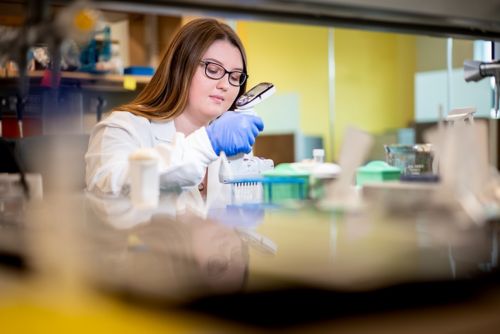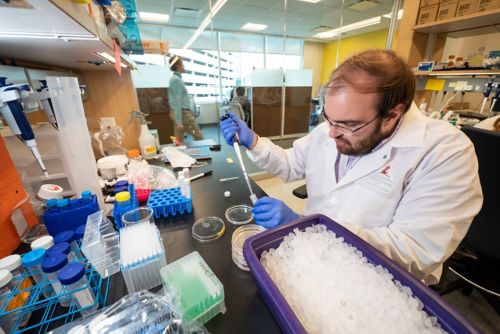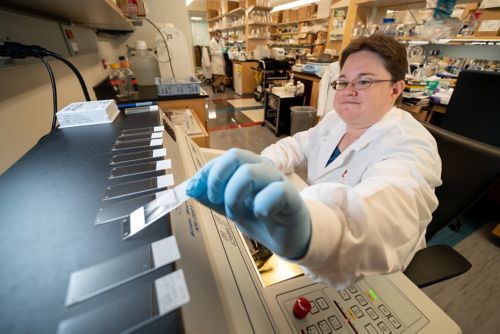St. Jude Family of Websites
Explore our cutting edge research, world-class patient care, career opportunities and more.
St. Jude Children's Research Hospital Home

- Fundraising
St. Jude Family of Websites
Explore our cutting edge research, world-class patient care, career opportunities and more.
St. Jude Children's Research Hospital Home

- Fundraising
Young-Goo Han Lab
Understanding development and dysfunction of the human brain through the lens of the neural progenitor cell
About the Han Lab
The human brain contains about 170 billion cells of many different types. Neural progenitor cells (NPCs) must produce this full spectrum of cell types during a limited developmental period. The process of proliferation and differentiation is exquisitely controlled by many factors. Changes in these control mechanisms can lead to larger or smaller brains, or alterations in neuronal wiring. Our laboratory is interested in defining the cellular and molecular mechanisms that control brain development and understanding how changes in these mechanisms lead to dysfunction. Our work holds the potential to provides insights into the pathology of neurodevelopmental disorders and the origins of pediatric brain tumors.

Our research summary
Mammalian brain sizes are very diverse, and human brains are three times larger, relative to their body size, than most mammals. Moreover, relative to their brain size, humans have the largest cerebral cortex with a gyrated, or folded surface. Humans’ unique mental abilities are rooted in this large, folded cerebral cortex. At early development stages, the brains of humans and mice are similar, but a robust expansion of neural progenitor cells, especially outer radial glial (oRG) cells, eventually gives rise to the undulated surface of the human brain. Signaling through the sonic hedgehog pathway (SHH) is necessary and sufficient for the expansion of this population of neural progenitor cells. SHH signaling activity is higher in the human brain, and patients with mutations or disruptions in SHH signaling often exhibit microcephaly. We ask targeted questions to understand the role of SHH in the context of normal development and tumorigenesis. Our group uses high resolution microscopy, -omics analysis, in utero electroporation, neural progenitor cell culture (organoid models), mouse genetics, and histology to interrogate developmental pathways.
Understanding SHH in neurodevelopment
Our group has created a transgenic mouse model that maintains activated SHH signaling in the brain. We have observed a significant increase in the presence and proliferation of oRG cells, in addition to emergence of folding or gyration (a feature not witnessed in murine species). We are focused on understanding the cellular and molecular mechanisms of oRG expansion as mediated by SHH signaling. Using RNA-Seq to analyze the transcriptomes of mutant mice compared to controls, we have identified both known and novel putative regulators. Further work will validate and define the specific roles of these factors in oRG expansion. In order to assess the role of candidates in human brain development, we utilize cerebral organoid systems derived from human pluripotent stem cells, as well as ferret models which naturally feature brain folding.

Investigating SHH signaling and primary cilia in pediatric brain tumors
Pediatric brain tumors are considered developmental, as they often arise from progenitor cells that have escaped normal proliferation control mechanisms. Each of the different types of pediatric brain tumors are thought to arise from specific types of neural progenitor cells. We hypothesize that oRG cells, which are vastly abundant in developing human brains, are cells of origin for certain pediatric high-grade gliomas. Conventional mouse models have few oRG cells which are necessary to interrogate molecular mechanisms, and so we are leveraging our SHH-model to decipher pathogenesis. Additionally, we are exploring the role of the primary cilium, the cellular antenna, as a factor in tumorigenesis. Our group has discovered that primary cilia have opposing roles depending on their presence or absence in a given tumor. In tumors with these structures, primary cilia seem to promote tumorigenesis, while in those without them, they serve to inhibit tumor development. At St. Jude, we have access to a complete database of human tissue samples that enables us to evaluate the connections between primary cilia and tumor subgroup.

Selected Publications
Contact us
Young-Goo Han, PhD
Associate Member
Department of Developmental Neurobiology
MS 325, Room M3403
St. Jude Children's Research Hospital

Memphis, TN, 38105-3678 USA GET DIRECTIONS